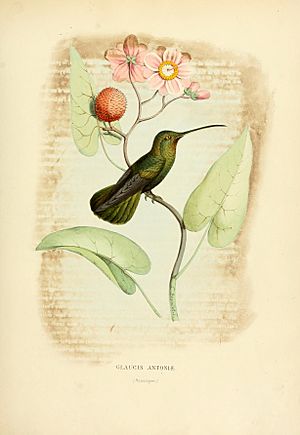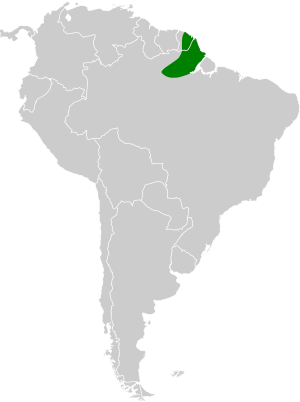Sooty barbthroat facts for kids
Quick facts for kids Sooty barbthroat |
|
|---|---|
 |
|
| Conservation status | |
| Scientific classification | |
| Genus: |
Threnetes
|
| Species: |
niger
|
 |
|
| Synonyms | |
|
Trochilus niger Linnaeus, 1758 |
|
The sooty barbthroat (scientific name: Threnetes niger) is a small, fast-flying bird. It belongs to the hummingbird family, called Trochilidae. You can find this special bird living in parts of Brazil and French Guiana.
Contents
About Its Name
The sooty barbthroat got its official name from a Swedish scientist named Carl Linnaeus. He described it in 1758 in his famous book, Systema Naturae. He first called it Trochilus niger.
Later, in 1852, another scientist named John Gould placed it in a new group, or genus, called Threnetes. This is why its full scientific name is Threnetes niger today.
Scientists often group animals that are very similar. The sooty barbthroat is part of a group of hummingbirds called a superspecies. This group includes the pale-tailed barbthroat and the band-tailed barbthroat.
What It Looks Like
The sooty barbthroat is a small bird, usually about 10 to 12 centimeters (4 to 5 inches) long. The male bird has shiny, bronze-green feathers on its back and chest. It has a black patch near its ear and a black throat. There's also a pale stripe on its cheek.
Its tail is usually dark, but some sooty barbthroats have pale tips on their tail feathers. The belly of the bird is a dark brownish-gray color. Its beak is mostly straight.
Male and female sooty barbthroats look quite similar. However, the female's beak is a bit more curved than the male's. Also, the colors on her throat, chest, and belly are not as bright. Young birds look like the adults, but their feathers have yellowish-brown edges.
Where It Lives
The sooty barbthroat lives in specific areas of South America. One group, called T. n. niger, is found in French Guiana and the northern part of Brazil's Amapá state. Another group, T. n. loehkeni, lives further south in Brazil, in Amapá and Pará states.
These birds like to live in warm, wet places. They can be found in open areas and partly open spaces within tropical forests. They also live in places like gallery forests (forests along rivers), swamp forests, and even old plantations. In French Guiana, they live from sea level up to about 500 meters (1,640 feet) high.
How It Behaves
Movement
Scientists believe that the sooty barbthroat stays in the same area all year round. It does not usually migrate to different places.
Feeding
Not much is known about how the sooty barbthroat finds its food. Like other hermit hummingbirds, it probably uses a special way of feeding called "trap-lining." This means it visits a set path of flowering plants again and again.
It drinks nectar from flowers, especially from Heliconia and Monotagma plants. It also eats small arthropods, which are tiny insects and spiders.
Reproduction
Scientists do not know much about how the sooty barbthroat breeds or raises its young. More research is needed to learn about its nesting habits.
Sounds It Makes
The sounds the sooty barbthroat makes have not been described very well. As of late 2021, there were no recordings of its calls available online.
Its Status
The IUCN (International Union for Conservation of Nature) has listed the sooty barbthroat as a species of "Least Concern." This means that it is not currently in danger of disappearing. However, scientists don't know exactly how many of these birds there are or if their numbers are changing. It is considered to be a local bird and generally not very common in the areas where it lives.
See also
 In Spanish: Ermitaño barbudo común para niños
In Spanish: Ermitaño barbudo común para niños


